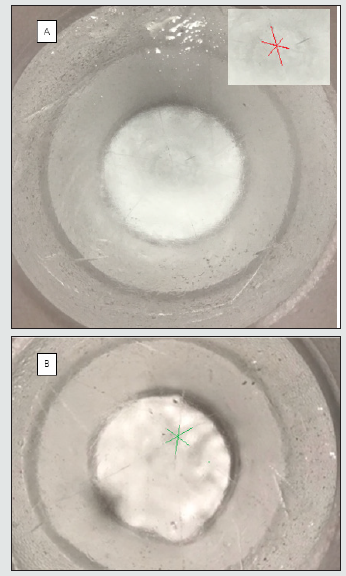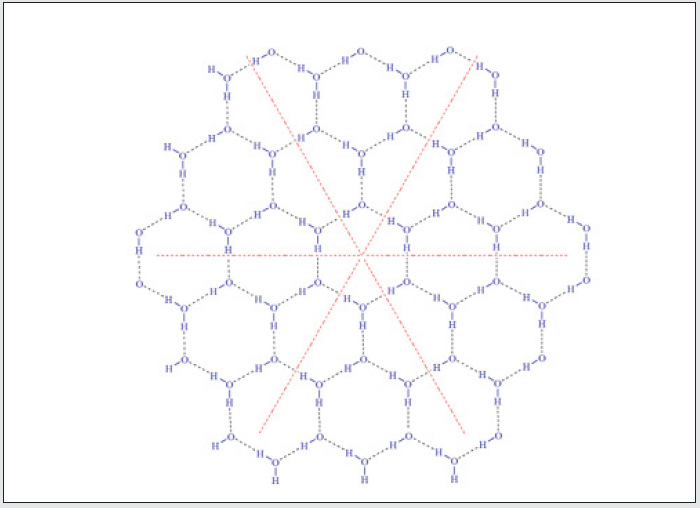
Lupine Publishers Group
Lupine Publishers
Menu
ISSN: 2637-4609
Mini-Review Article(ISSN: 2637-4609) 
Directed Collective Breakage of Hydrogen Bond in Ice Volume 5 - Issue 2
Hai-Feng Ji1*, Victoria Jacob2, Chaselynn Jiannotti3, Katerina Evangelou4 and Luphi Gao1
- 1Department of Chemistry, Drexel University, USA
Received:April 25, 2021; Published:June 7, 2021
*Corresponding author:Hai-Feng Ji, Department of Chemistry, Drexel University, USA
DOI: 10.32474/AOICS.2021.05.000208
Introduction
We present an observation of directed collective breaking of hydrogen bonds from ice crystals when a force is applied on an ice disk. Most of the ice disks broke into 6 pieces at the point of contact with a 60° angle, indicating the directed collective breaking of the ice crystals.
Since the formula of water, H2O, was discovered two centuries ago by Amedeo Avogadro, researchers have remained interested in the properties of water-one of the top questions driving life science in the 20th century. Some fundamental questions are still not fully answered, such as, “how many bonds does each H2O molecule makes with its nearest neighbors?”, which was listed as one of the top 100 questions spanning the sciences in 2005.
Compared to water, the hydrogen bonding in its ordered solid crystalline phase, ice, is well studied. All ice in the biosphere possesses a hexagonal crystal structure, ice Ih (known as ice one h or ice-phase-one), due to the hydrogen bonding (Figure 1). The structure of ice Ih can be considered as crinkled sheets composed of hexagonal rings with one oxygen atom on each vertex of the rings [1-2]. Each water molecule makes a maximum of four hydrogen bonds with neighboring molecules in the sheet and between sheets with near tetrahedral bonding angles. The hydrogen bonds are on the edges of the hexagonal rings. The hydrogen-bonded hexagonal rings are the mechanism that causes symmetrical and hexagonal structures in snowflakes.
This crystal structure of crystal ice Ih has been known for almost a century since it was first proposed by Linus Pauling [3]. One of the remaining fundamental chemistry questions about the crystal structure of ice is whether, under a certain condition, the hydrogen bonds break collectively in a controlled manner, i.e., the breaking of a series of H-bonds along one direction, such as along the dash lines shown in (Figure 1). If the hydrogen bonds break collectively along the six directions from the center, it is expected the ice will break into six pieces with each one having a 60° angle from the center. From a mechanical engineering point of view, the ice should have an anisotropic property starting from any point of the ice. This mechanical property of ice has not been studied. In this short report, we demonstrate that a thin piece of ice does break upon a shock/hit on the ice at the point of contact. The ice breaks into six pieces with the expected angle. This might be the first example of direct observation of the collective breaking of hydrogen bonds along the expected direction in a controlled manner.
In our experiments, 150 mL of water was added to a 251 mL Styrofoam cup. Next, the cup was placed inside the freezer at -6°C. The ice disk with a diameter of 6.5 cm formed after 2 hours, 3 hours, 4 hours, and 5 hours are roughly 2 mm, 3 mm, 4 mm, and 5 mm, in thickness, respectively. The cup was taken out of the freezer once the desired thickness had formed [4-6]. The ice disk was then ready for testing. Square ice disk was prepared under a similar condition.
The impact force test of ice disks was conducted using a 17 g round steel ball initially released from rest. All experiments were done in pentaplicate. The average impact force at the surface of the ice disk is defined as F = mgh/d, where m is the mass of the falling ball, g is the acceleration of gravity, h is the initial height of the falling ball, and d is the distance traveled after impact.
As shown in (Figure 2a), when a round-shape ball hits the ice, the ice cracks into 6 pieces when the shock energy at impact is greater than the energy required to break the hydrogen bonds holding the H2O molecules together. The angles were measured to be 60°. When the cracks extended further, the lines were not straight in most samples (Figure 2 a and b), which might be due to the slight hydrogen disorder in the ice.
Figure 2: One piece of ice broke into 6 pieces when a ball hit at the center. The thickness of the ice disk was 3 mm, and the impact force was 2 N

The results are similar when square ice flakes were used. When the ball hit the ice too hard, the ice was smashed into multiple small pieces. When the energy was insufficient, less than six pieces were observed (Figure 3a), but the 60° or 2 × 60° angles were still observed. This phenomenon has also been observed in nature on a river (Figure 3b).
Figure 3: A) A piece of ice breaks into 4 pieces when a ball hit at the center. B) A piece of ice on a frozen river breaks into 6 pieces when a ball hit at the center.

Conclusion
Anisotropy, in materials science, means the physical properties of a material are directionally dependent. Nearly all single crystals, including ice, are anisotropic regarding mechanical properties. The anisotropic cracking of single-crystal ice is of interest itself in understanding the physical properties of ice. The potential applications of this property of ice are worthy to be investigated, such as in the studies of propagation of seismic waves, the flow behavior of ice, viscosity of the ice, etc.,
References
- Kennedy D, Norman C (2005) what don’t we know? Science 2005, 309(5731): pp.75.
- Petrenko VF (1993) Structure of Ordinary Ice Ih. Part 1: Ideal Structure of Ice Paperback. US Army Corp of Engineers Cold Regions Research &Engineering Laboratory 1-20.
- Pauling L (1935) The Structure and Entropy of Ice and of Other Crystals with Some Randomness of Atomic Arrangement. J Amer Chem Soc 57(12): 2680-2684.
- Bernal JD, Fowler RH (1933) A Theory of Water and Ionic Solution, with Particular Reference to Hydrogen and Hydroxyl Ions. J Chem Phys 1(8): pp. 515.
- Diez, O Eisen (2015) Seismic wave propagation in anisotropic ice -Part 1: Elasticity tensor and derived quantities from ice-core properties. The Cryosphere 9(1): 367-384.
- Pimienta P, Duval P (1987) The Physical Basis of Ice Sheet Modelling” (Proceedings of the Vancouver Symposium). IAHS Publ.

Top Editors
-

Mark E Smith
Bio chemistry
University of Texas Medical Branch, USA -

Lawrence A Presley
Department of Criminal Justice
Liberty University, USA -

Thomas W Miller
Department of Psychiatry
University of Kentucky, USA -

Gjumrakch Aliev
Department of Medicine
Gally International Biomedical Research & Consulting LLC, USA -

Christopher Bryant
Department of Urbanisation and Agricultural
Montreal university, USA -

Robert William Frare
Oral & Maxillofacial Pathology
New York University, USA -

Rudolph Modesto Navari
Gastroenterology and Hepatology
University of Alabama, UK -

Andrew Hague
Department of Medicine
Universities of Bradford, UK -

George Gregory Buttigieg
Maltese College of Obstetrics and Gynaecology, Europe -

Chen-Hsiung Yeh
Oncology
Circulogene Theranostics, England -
.png)
Emilio Bucio-Carrillo
Radiation Chemistry
National University of Mexico, USA -
.jpg)
Casey J Grenier
Analytical Chemistry
Wentworth Institute of Technology, USA -
Hany Atalah
Minimally Invasive Surgery
Mercer University school of Medicine, USA -

Abu-Hussein Muhamad
Pediatric Dentistry
University of Athens , Greece

The annual scholar awards from Lupine Publishers honor a selected number Read More...






